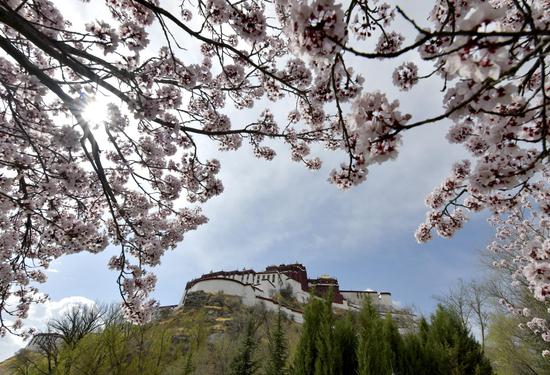Braving high winds and occasional sandstorms, Du Wenhua and his co-workers engaged in meticulously orchestrated efforts to afforest an expansive stretch of sand dunes and deserts in North China's Inner Mongolia autonomous region.
It took them less than five minutes to plant a saxaul sapling, which can survive with minimum water in arid conditions. They plan to afforest over 5,000 hectares of sandy areas this month to protect farmland from nearby deserts.
Over the past decades, Du has led the workers of the Xinhua Forest Farm in Bayannuur to spearhead the charge against the bastions of desertification, planting over 2.8 million trees to transform barren land into belts of green resistance.
The forest farm stands at the forefront of China's Three-North Shelterbelt Forest Program, which was launched in 1978 to hold back the expansion of the Gobi Desert. The project, which spans 13 provincial-level regions in the nation's northwestern, northern and northeastern regions, is expected to be completed by 2050. It also epitomizes China's broader efforts to fight desertification and build a beautiful country.
The farm received an important guest in June, when President Xi Jinping, who is also general secretary of the Communist Party of China Central Committee, made a fact-finding trip to the farm in northern China to learn about the progress in the shelter forest program and inspect the sandy land under transformation.
"For the better survival and development of humanity, the prevention and control of desertification is a must. This is a process akin to pushing a rock uphill, where any relaxation could lead to regression," Xi told workers at the farm.
The president used the trip to Inner Mongolia to call for sustained efforts to create new miracles in tackling desertification, setting out a target to develop the Three-North program into an unbreakable "green Great Wall" within 10 years.
Xi renewed that commitment on Wednesday when he joined volunteers at a tree-planting event in Beijing.
After planting a number of saplings at a forest park in the capital's Tongzhou district, Xi told the crowd gathered at the site that the event is aimed at encouraging people to take actions and join the country's afforestation efforts to add a greener hue to the building of a beautiful China.
He underlined the Three-North region as the main battlefield for national greening efforts, saying that more resources should be concentrated on the construction of the Three-North program to fortify the "green Great Wall" in northern China.
The trip to Inner Mongolia and his participation in the tree-planting event were part of Xi's broader engagement in national efforts to fight desertification and promote the greening of the country.
Since he took the Party's top office in November 2012, Xi has taken part in afforestation efforts in the Chinese capital every year. He has also visited at least three forest farms over the past four years, highlighting the importance of making parallel efforts in afforestation and protection of forests.
According to the National Forestry and Grassland Administration, China has completed afforestation over an area of 112 million hectares in the past decade, increasing the nation's forest coverage to 231 million hectares.
China's forest coverage exceeded 24 percent as of 2023, while the area of its man-made forests reached 87.6 million hectares, ranking first in the world.
Cheng Xiaoqin, an associate professor of forest ecology at Beijing Forestry University, said the strong emphasis from China's top leadership has been instrumental in the nation's success in pushing back the expansion of deserts and expanding its forest cover.
"Through his personal involvement in tree-planting events and close interaction with forest farm workers, the president has inspired the general public to actively participate in ecological construction," she said.
"Pursuing green development and promoting harmony between humanity and nature is at the heart of China's afforestation programs," Cheng added.
Call for further action
Du, from the Xinhua Forest Farm, still remembers every detail of his interaction with Xi. "I found the president to be very approachable and kind. It was like a conversation between family members."
During his visit to the forest farm, Xi carefully inspected a desert false indigo shrub by the roadside, while Du explained the plant's drought-resistant and flood-tolerant nature, and its well-developed root system.
The president offered recognition to the workers at the farm for their approaches to selecting saplings that are most adaptable to the desert environment.
On Wednesday, Xi reiterated the significance of advancing large-scale national afforestation in a scientific manner, saying that the right variety of tree should be chosen for the right place to ensure that every sapling planted grows and every afforested area flourishes.
Xi emphasized the imperative need to put in place sound efforts for fire prevention and control in order to safeguard the hard-won results of afforestation.
Du said the farm has now broadened its focus to nurturing sapling nurseries and implementing fire prevention measures, thereby ensuring the sustainable development of the area.
"For me, taking a walk under the shade of forests we planted is the largest source of my personal accomplishment," he added.
Yuan Xiaodong, deputy head of the forestry and grassland bureau of Bayannuur, said the messages from Xi represented the latest call for actions to step up the battle against desertification.
The messages have enabled local authorities to come up with new action plans, setting new benchmarks for the in-depth advancement of the Three-North program, Yuan said.
He added that the battle against desertification must effectively address sand encroachment, water damage, salinization, problems with protective forests and overgrazing on grassland as well as better ensure the protection of rivers, lakes and wetlands.
Xi reiterated on Wednesday that China still has a long way to go in terms of its afforestation efforts, saying that the nation continues to face significant challenges, with a lack of forests and greenery and the potential wealth of forests not being fully tapped.
The nation's tree-planting programs must be conducted one season after another, and also one generation after another, in order to secure China's "green assets", he said.
The central government has earmarked 12 billion yuan ($1.66 billion) this year to support the continuous implementation of the Three-North program.
Cheng, from Beijing Forestry University, said the sustained development of the Three-North program will build up the resilience and stability of ecosystems in the nation's arid northern regions, and promote the coordinated development of ecology, environment and the economy.
"The nation should and must continue with a holistic and systematic approach to conserving and improving mountain, water, forest, farmland, grassland and desert ecosystems in the Three-North region, and ensure these ecosystems are healthy, stable and fully functional," she said.


















































 京公网安备 11010202009201号
京公网安备 11010202009201号
